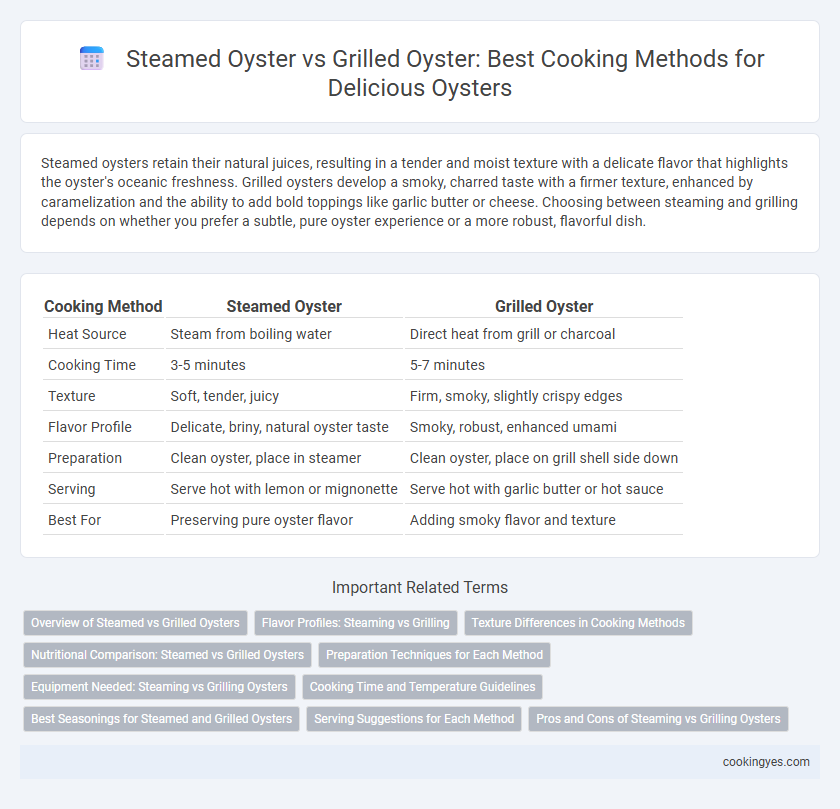Steamed oysters retain their natural juices, resulting in a tender and moist texture with a delicate flavor that highlights the oyster's oceanic freshness. Grilled oysters develop a smoky, charred taste with a firmer texture, enhanced by caramelization and the ability to add bold toppings like garlic butter or cheese. Choosing between steaming and grilling depends on whether you prefer a subtle, pure oyster experience or a more robust, flavorful dish.
Table of Comparison
| Cooking Method | Steamed Oyster | Grilled Oyster |
|---|---|---|
| Heat Source | Steam from boiling water | Direct heat from grill or charcoal |
| Cooking Time | 3-5 minutes | 5-7 minutes |
| Texture | Soft, tender, juicy | Firm, smoky, slightly crispy edges |
| Flavor Profile | Delicate, briny, natural oyster taste | Smoky, robust, enhanced umami |
| Preparation | Clean oyster, place in steamer | Clean oyster, place on grill shell side down |
| Serving | Serve hot with lemon or mignonette | Serve hot with garlic butter or hot sauce |
| Best For | Preserving pure oyster flavor | Adding smoky flavor and texture |
Overview of Steamed vs Grilled Oysters
Steamed oysters retain a tender, juicy texture with a delicate briny flavor enhanced by gentle heat, making them ideal for preserving natural oyster taste and moisture. Grilled oysters develop a smoky, robust flavor and slightly firmer texture due to direct exposure to high heat and open flames, often complemented by charred edges and added seasonings. Both methods highlight unique sensory profiles, with steaming showcasing purity and grilling emphasizing depth and complexity in oyster preparation.
Flavor Profiles: Steaming vs Grilling
Steamed oysters retain a delicate, briny flavor with a tender, moist texture that highlights the ocean's natural sweetness. Grilled oysters develop a smoky, charred taste with a slightly firmer bite, enhanced by caramelized edges and infused with smoky aroma. Both methods emphasize distinct flavor profiles, making steamed oysters more subtle and fresh, while grilled oysters offer a robust, savory experience.
Texture Differences in Cooking Methods
Steamed oysters retain a tender, moist texture due to gentle heat that preserves their natural juices, resulting in a soft and succulent bite. Grilled oysters develop a firmer, slightly charred exterior with a smoky flavor, creating a contrast between the crisp edge and creamy interior. The cooking method distinctly impacts oyster texture, with steaming emphasizing softness and grilling enhancing bold, textured complexity.
Nutritional Comparison: Steamed vs Grilled Oysters
Steamed oysters retain more water-soluble vitamins such as B12 and vitamin C compared to grilled oysters, which may lose some nutrients due to direct high heat exposure. Grilled oysters, however, often have enhanced minerals like zinc and iron concentration due to moisture reduction during cooking. Both methods preserve protein content well, but steaming is generally superior for maintaining overall nutritional value, especially delicate antioxidants and vitamins.
Preparation Techniques for Each Method
Steamed oysters require placing fresh oysters in a covered pot with water or broth, allowing steam to gently cook them and retain their natural briny flavor and tender texture. Grilled oysters involve direct heat from a grill, often with added seasonings or butter, creating a smoky, charred taste and slightly firmer texture. Both methods prioritize freshness, but steaming emphasizes moisture retention while grilling enhances smoky flavors.
Equipment Needed: Steaming vs Grilling Oysters
Steaming oysters requires a pot with a fitted lid and a steaming rack or basket to hold the oysters above the boiling water, ensuring even heat distribution and gentle cooking. Grilling oysters demands a grill or barbecue with a stable rack, often using direct heat and sometimes wood chips for added smoky flavor, along with tongs to handle the hot shells safely. Both methods rely on equipment that maintains heat and supports the oysters securely, but steaming emphasizes moisture retention while grilling enhances char and smoky notes.
Cooking Time and Temperature Guidelines
Steamed oysters typically cook at 212degF (100degC) for about 5 to 10 minutes, allowing the shells to open naturally while preserving the oyster's delicate texture and briny flavor. Grilled oysters require higher heat, around 450degF (232degC), and a shorter cooking time of 5 to 7 minutes, resulting in a smoky char and slightly firmer texture. Both methods depend on shell opening as an indicator of doneness, ensuring optimal safety and taste.
Best Seasonings for Steamed and Grilled Oysters
Steamed oysters benefit from light, delicate seasonings such as garlic butter, lemon juice, and fresh herbs like parsley or thyme to enhance their natural briny flavor without overpowering it. Grilled oysters pair well with bold, smoky seasonings including Cajun spice blends, hot sauce, and melted cheese for a rich, savory taste. Both cooking methods highlight the oyster's unique taste while offering distinct flavor profiles through carefully chosen seasonings.
Serving Suggestions for Each Method
Steamed oysters offer a tender, juicy texture ideal for topping with classic mignonette or a squeeze of fresh lemon to enhance their natural brininess. Grilled oysters develop a smoky, charred flavor that pairs perfectly with rich garlic butter, parmesan cheese, or spicy aioli for an indulgent serving experience. Both methods benefit from fresh herbs like parsley or cilantro to add brightness and complement the oyster's oceanic taste.
Pros and Cons of Steaming vs Grilling Oysters
Steamed oysters retain a tender texture and preserve the natural briny flavor, making them ideal for those who prefer a moist and delicate taste, but they may lack the smoky depth that grilling imparts. Grilled oysters develop a charred, smoky complexity and firmer texture, enhancing bold flavors, yet grilling risks overcooking and drying out the oysters if not carefully managed. Steaming offers a gentler cooking method that maintains juiciness with minimal seasoning, whereas grilling introduces robust, smoky notes suited for adventurous palates seeking a more intense oyster experience.
Steamed Oyster vs Grilled Oyster for cooking method Infographic

 cookingyes.com
cookingyes.com